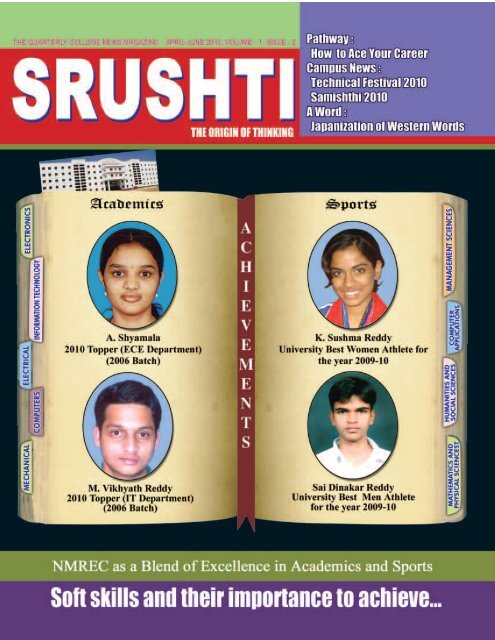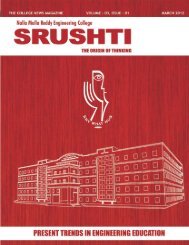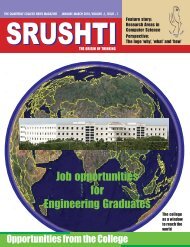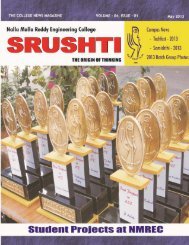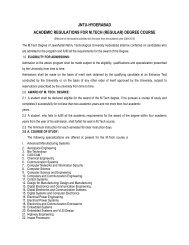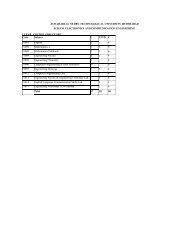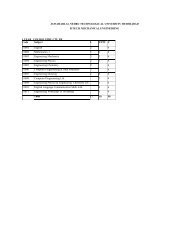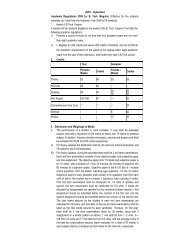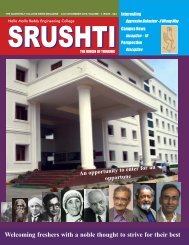Cover Story - Nalla Malla Reddy Engineering College
Cover Story - Nalla Malla Reddy Engineering College
Cover Story - Nalla Malla Reddy Engineering College
- No tags were found...
You also want an ePaper? Increase the reach of your titles
YUMPU automatically turns print PDFs into web optimized ePapers that Google loves.
FEATURE STORY SRUSHTI April -June, 2010Scope of StatisticsEverything dealing with the collection,processing, analysis and interpretation ofnumerical data belongs to the domain ofStatistics. This includes such diversifiedtasks as calculating the average length of downtimesof a computer, collecting and presenting data on thenumbers of persons attending seminar on solar energy,evaluating the effectiveness of commercial products,predicting the reliability of a rocket, or studying thevibrations of airplane wings.Why Study Statistics?Answers provided by statistical analysis can providethe basis for making decisions or choosing actions.For example, city officials might want to know whetherthe level of lead in the water supply is within safetystandards. Because not all of the water can be checked,answers must be based on the partial information fromsamples of water that is collected for the purpose. Wheninformation is sought, statistical ideas suggest a typicalcollection process with four crucial steps.(1) Set clearly defined goals for the investigation;(2) Make a plan of what data to collect and how tocollect it. (3) Apply appropriate statistical methods toextract information from the data. (4) Interpret theinformation and draw conclusions. Statistical reasoningand methods can help become efficient at obtaininginformation and making useful conclusions.Applications of StatisticsStatistics has wide applications in almost all sciences– social as well as physical – such as biology,psychology, education, economics, businessmanagement etc.Statistics and Business: Statistics is used in studyingthe needs and desires of the consumers and inproduction planning and control. The success of abusiness man almost depends upon the accuracy andprecision of his statistical forecasting.Statistics and Insurance or Actuarial Science- Inestimating the probabilities of longevity at differentages of persons, vehicles Vital Statistics is used inconstructing mortality or life tables and hence incalculating premium rates for different policies.Statistics and Banking- In finding probabilities ofdefault of loan takers. Logistic regression is used toassign default probabilities to the loan takers dependingon various factors. On cherishing given standard, wegroup them under ‘likely to default’, and ‘unlikely todefault’ in the future.Statistics and Financial Services- In modeling andprediction of interest rates like LIBOR, in evaluatingdifferent risks – credit, market and operational. Incalculating VaR (Value at Risk). Principal ComponentsAnalysis (PCA) is used in identifying the contributionof different factors affecting a phenomena.Statistics and Marketing and / or Market Research- Inanalyzing customers’ response, churn prediction,reduction, and market basket analysis. Multivariatetechniques like factor analysis, cluster analysis,multiple regression analysis, discriminant analysis,CHAID (Chi-square Interaction Detector) etc. arevastly used in marketing. Descriptive statistics likemean, standard deviation, standard error, frequencytables; chi-square test are often calculated and reportedto the client in market research using a sophisticatedprogramming language called ‘Quantum’.Statistics and software packages / languages- SAS(stands for Statistical Analysis System), is used in bigsized companies, SPSS (stands for Statistical Product*Contributor: D. Srinivas Assistant Professor, Department of Mathematics and Physical Sciences6
SRUSHTI Volume - 1, Issue -2and Service Solutions) is used in small and mid-sizedcompanies for analyzing, interpreting data andsuggesting action points or recommendations forcommercial purposes.Statistics and Planning- In order that planning issuccessful, it must be based soundly on the correctanalysis of complex statistical data. On analyzingcensus (complete enumeration of population conductedevery 10 years in India) data using statistical methodsgovernments formulate different programs or policies.Statistics and Economics- Statistics is immenselyuseful in solving a variety of economics problems, suchas wages, prices, analysis of time series and demandanalysis in estimating demand functions, in studyingthe behaviour of economic variables. It also facilitatesthe development of economic theory. Wideapplications of mathematics and statistics in the studyof economics have led to the development of newdiscipline called Economic Statistics or Econometrics.Statistics and Industry- In manufacturing or productionindustry. Statistical methods viz., sampling, inspectionplans, control charts, Operation Characteristic curves(OC curves), ASN (Average Sample Number)functions etc are very widely used in ‘Quality Control’.Statistics and Mathematics- Statistics and mathematicsare very intimately related. Recent advancements instatistical techniques are the outcome of wideapplications of advanced mathematics. Increasing roleof mathematics in statistical analysis has resulted in anew branch of Statistics called Mathematical Statistics.Statistics and Biology, Astronomy and MedicalScience- According to Karl Pearson, the whole ‘theoryof heredity’ rests on statistical basis. He says, “Thewhole problem of evolution is a problem of vitalstatistics, a problem of longevity, of fertility, of health,of disease, and it is impossible for the Registrar Generalto conclude about the national mortality withoutenumeration of the population, a classification ofdeaths and knowledge of statistical theory.”Application of Statistics in Biology has resulted in anew discipline called ‘Biostatistics’.In astronomy, the theory of Gaussian ‘Normal Law ofErrors’ for the study of the movement of stars andplanets is developed by using the ‘Principle of LeastSquares’.In medical science and or pharmacy, the statisticaltools for the collection, presentation and analysis ofobserved facts relating to causes and incidence ofdiseases and the results obtained from the use ofvarious drugs and medicines, are of great importance.Moreover, the efficacy of a manufactured drug orinjection or medicine is tested by using the test ofsignificance – paired t-test. ANOVA is used extensivelyin pharmacy in comparing the breaking strength ofdifferent tablets (3 or more types).Statistics and Psychology and Education- To determinethe reliability and validity of a test. The use of Statisticsin psychology has resulted in a new subject called‘Psychometry’. In comparing the effectiveness of threeor more teaching methods, ANOVA is used.Correlation and regression analysis is used extensivelyin Psychology.Statistics and War- In war, the theory of ‘DecisionFunctions’ can be of great assistance to military andtechnical personnel to plan ‘maximum destruction withminimum effort’.Operations Research (OR) and its ApplicationsOR is a branch of Statistics. It is a scientific approachusing quantitative techniques as a tool in decisionmaking, and is also known as ‘Quantitative Analysis.’It is concerned with scientifically deciding how to bestdesign and operate man-machine systems usuallyrequiring the allocation of scared resources. Nowadaysit is difficult to find an area of business or governmentwhich doesn’t benefit from Operations Research.(i) AccountingForecasting cash flows; Management of accountsreceivable; Deciding which customers to give credit7
FEATURE STORY SRUSHTI April -June, 2010and how much; Assigning audit teams effectively;Developing standard costs.(ii) FinanceBuilding cash management models; Allocating capitalamong various alternatives; Managing an investmentportfolio; Forecasting long range capital needs;Building financial planning models; Determine optimaltimes to replace equipment; Deciding on the mosteffective dividend policy.(iii) MarketingDetermining the best product-mix to market; Effectiveallocation of advertising budget among various media;Finding the best time to introduce new product;Locating warehouses to minimize distribution cost;Planning salesperson travel to minimize travel time andcost; Assigning sales people to customers to maximizesales effectiveness; Deciding on the most effectivepackaging alternative; Finding least cost shippingarrangements from plant to customers.(iv) Production or OperationsBalancing plant capacity with market requirements;Leveling a product schedule to minimize hiring andlay-offs; Smoothing production schedules whendemand is seasonal; Minimizing in-process inventory;Moving products through the manufacturing processin the shortest time; Determining landing and take-offschedules for large airports; Deciding whether tomanufacture or purchase components (Make-or-BuyAnalysis); Balancing an assembly line which has manydifferent operations; Locating a new plant in the mosteffective location; Allocating research anddevelopment budgets most effectively; Choosing thebest size for a new plant or warehouse; Planning thelong time manufacturing capacity of a company;Scheduling jobs to improve capacity(v) Organizational development or human resourcesCoordinating man power needs in a seasonal business;Deploying field sales force optimally; Determininghow to negotiate in a bargaining situation; Schedulingtraining programs to maximize skill development andretention; Designing organization structures moreeffectively.Basic Statistical TechniquesFollowing are some of the basic statistical techniqueswhich are used in the above mentioned fields:Probability: The numerical measure of the chance ofan event. It lies between 0 and 1.Example: When three coins are tossed the set of alloutcomes of this experiment is {HHH, HTH, HHT,TTH, THH, HTT, TTT, THT}. Let the event E = Allthe 3 coins turn up the same = {HHH, TTT}.If E can happen in h ways out of a total of n equallyhlikely ways, the probability of the event = n2 1= = = 0.258 4i.e., 25% of chance is there for all the 3 turning up thesame when 3 coins are tossed.(Probability) Distributions: The set of all values ofrandom variables and their associated probabilities.Example: If we roll a fair die, the sample space, S ={1,2, 3, 4, 5, 6}. Random variable say X is the value thatturns up on the die when it is thrown. Since the die isfair, each of 1, 2, 3, 4, 5, and 6 has an equal chance(1/6) for turning up. Then the probability distributionof X is P(x) = 61 , for x = 1, 2, 3, 4, 5, 6. i.e.,X=x 1 2 3 4 5 6P(x)161616Tests of hypothesis: A supervisor is told by the plantowner that the thickness of the copper plating for acertain type of product must not be less than 0.001inch in order for the process to be in control, thesupervisor might formulate a test. He could hypothesizethat the process is in control – that is, assume that theaverage thickness of the copper plating is 0.001 or1616168
SRUSHTI Volume - 1, Issue -2greater – and use samples from several days ofoperation to decide whether or not his hypothesis iscorrect. The supervisor’s decision making approach iscalled test of hypothesis.Example: The average weekly earnings for women inmanagerial and professional positions are $670. Domen in the same positions have average weeklyearnings that are higher than those for women? Arandom sample of n = 40 men in managerial andprofessional positions showed = $725 and S= $102.Test the appropriate hypothesis using α = 0.01.Applying the apt test statistic z = ( - µ o) / (S /), wecan conclude that the men in managerial andprofessional positions have average weekly earningsthat are higher than those for women.Correlation and Regression: The linear relationshipbetween two variables is measured by correlation andthe average relationship between a dependent variableand one or more independent variables is measured byregression.Correlation example, a strong negative correlationexists between anxiety and emotional stability. Personswho score higher in anxiety tend to score lower inemotional stability.Regression example: The relationship between preexamanxiety and score in exam is an example ofregression. The hypothesis for a linear relationshipmight be that those with very low anxiety will do poorlybecause they don’t care much and those with highanxiety will do better because they are motivated tospend more time in preparation.Queuing Theory: The objective of queuing analysisis to offer a reasonably satisfactory service towaiting customers. It is used to find the service levelfor an organization that minimizes both i) cost ofwaiting time and ii) cost of providing service.Stochastic Process: Stochastic process is a techniquethat deals with the probabilities of future occurrenceby analyzing presently known information. Thetechnique has numerous applications including marketshare analysis, bad debt prediction and determiningwhether a machine will break down in the future.ConclusionWe have discussed – the necessity to study Statistics,various disciples where its methods are applied, thedisciplines where OR is used. In view of the necessityfor studying statistics, it’s better for all graduates tohave a basic course in statistics. Knowledge of Statisticshelps one become adept at obtaining information andmaking useful conclusions. While interpreting theresults of statistical analysis a statistician has to cherishthe practical significance of the results.9
A WORD SRUSHTI April -June, 2010Japanization of Western WordsIt is a general belief that the japanese had been illiteratebecause of no method of writing till the end of 4 thcentury, before they were exposed to Chineseideograms, which they adapted to their language. Notonly had they learned Chinese characters, but they inventedthe “HIRA-GANA” and the “KATA-KANA” letters. Butafter the 16 th century that many European words came to beintroduced into Japan. At present the KATAKANA is usedexclusively to transcribe foreign words and proper namesother than Korean and Chinese ones. It is impossible toshow their original pronunciation precisely in theKATAKANA. The KATAKANA letters are exactly like theRoman letters in which they represent the sound. Whenwritten in Chinese the names can bear meaning, but theiroriginal English spellings dont. For example; Coca-colaliterally means “PLEASANT TO THE PLATE ANDENJOYABLE”.A closer study of borrowed words in the Japaneselanguage will enable you to discover that they have asurprisingly rich variety of sources and origins. The Englishword STRIKE, for instance is pronounced in at least twoways- SUTORAIKU for baseball umpires call behind theplate and SUTORAIKU for a labor dispute. The mixing upof both words invites laughs of ridicule. The word KOPPUhas come from the Portuguese COPO or the Dutch KOPrather than from English CUP, as in general thought.Portugal and Netherland were the only European nationsallowed to trade with Japan during the quiet periods of herself-imposed political isolation. The substance GARASUand kitchen utensil GURASU seem to originate from theDutch GLAS.It may seem strange to non-native Japanese to notice thatthere is no distinction between “1” and “r” in RomanizedJapanese spelling. For convenience sake the former is alwayssubstituted by the latter, but the Japanese consonant soundrepresented by “r” in Romanized spelling is more like “d”than “r”. So, when Romanized LEADER and READER (bothJapanized) are pronounced alike. So also LIGHTER andWRITER. After the Meiji Era and especially the terminationof World War II, the role of KATAKANA in the Japaneselanguage has become and more important and it finally hasgiven rise to “KATAKANA go”.A Japanese, unless linguistically trained, is very likelyto take a T.V. set for T.B. patient. Japanese traditionalKATAKANA writing of T.V and T.B, is a pair of peas, bothbeing transformed in Romanized Japanese into identicalspelling of TIBI. With an apparent view to avoid thisexpected confusion, the Japanese have tenaciouslycontinued to refuse the acceptance of the now popularshortened word for TELEVISION. They are instead satisfiedwith their own version of TEREBI which is one particularexample of KATKANA-go. Similarly the word pao is alsoconsidered to be the mother of the Japanese word PAN,which means ‘bread’ in general. A group of linguistics oncestated that the word derives from the Dutch words“CASTILLA BROOD” (castilla bread), but they soonconceded to the claim of Portuguese on learning of theinclusion of the word, together with KOMPEITO authoredby oze in 1625, when no Dutch influence had yet come toJapan. KOMPEITO-sugar coated sweet-meat balls. Thisword is also taken from Portuguese “confeito” and wasmentioned as early as in 1687 by Thara Saikaku.Both KASUTERA and KOMEITO have so often beenquoted spoken of and written about, that the present daychildren may prefer chocolate candies, fudges and othersweets that they now look like Japanese nature.The leading japaneses scholars have long talked aboutARUBATO, adapted from the German “Arbeit” but itsmeaning has changed a lot over the years. Before and duringthe World War II they referred to it as their “effort inscholastic research in their speciality, but since the end ofthe war the word has been commonly referred to as an“outside job which helps them to earn pocket money”.For a year or two prior to the 1964 Olympic Gamesheld in Tokyo, various organizations the country advisedpeople against the thoughtless use of Japanese coinedforeign words and phrases in detail with “respectable” ladiesand gentlemen coming for the games from abroad.Here are some examples of Japanese-coined westernwords and phrases.1. AFUTA SABISU- After Service2. ARUBAITO SARON-From German Arbeit and fromFrench Salon3. EA-KON-From Air conditioner. Other combinations ofKon are as follows:RIMA-KNO-Remote controlRAJI-KON-Radio ControlledORA-KON-Oratorical ContestRESHI-KON-rectation contest4. HAI-SENSU-From High senseContracted form may remind you of such English wordsoften heard in college campus as BIB-Bibliography. Lit.and so on. Even the American English has quite a fewexamples of corruption of imported words.*Contributor: Prof. Ramachandra, Head Department of Electronics and Communication <strong>Engineering</strong>10
PATHWAY SRUSHTI April -June, 2010How To Ace Your Careerwe guide you on the path of excellence whether yourdestination is a job or higher educationAbrand new academic year! Welcome aboard – fasten your seat belts and get ready for an enjoyableflight and a safe landing! And for a change, this flight is not a boring one where you are a passiveobserver, but one where the crew is going to engage you in some fun and learning.Isn’t a professional degree a ticket to a better future? Don’t you want to ‘land’ in a chosen job or course?You don’t want to ‘crash land’ or do an emergency exit, right? I am sure you don’t want to be frustrated becauseof a lack of opportunities or because you’re doing something that doesn’t interest you.Imagine making a dish without adding sugar or jaggery in it. Can you expect it to be sweet? No, don’t be afool, you will say. It is equally foolish to expect success, if you do not put in the ingredients required to bring yousuccess in whatever avocation you choose.Many of you must have seen the movie ‘3 Idiots’ and must have discovered the need for excellence.However, no one defines excellence. What is it? And how do I reach it? These must be questions in your head.How come some students seem to perform better by their own initiative? Or are they really more intelligent orexcellent by nature?Our college has attempted to provide you answers to all your questions. Just read on.A few months back, the Centre For Faculty Development And Management (CFDM), after researchingNASSCOM reports, industry standards and having discussions with experts, decided to take some steps toimplement active learning methods and help you achieve thinking skills and knowledge for a successful careerin the 21 st Century.Course Objectives: The faculty has worked hard for the past few weeks to create course objectives – whatexactly you will be able to do by the end of a particular topic in a subject. This way of writing expectedoutcomes offers many advantages over the traditional method of listing out topics to be studied. An example issaying ‘after this unit you will be able to explain why a particular numeric type can only represent numbers in aparticular range,’ instead of saying, ‘the topic is number representation in computers’.These objectives are written keeping in view the Higher Order Thinking Skills (HOTS) required for a job.If you rely heavily on memorizing and reproducing answers to pass exams, you may get good marks, but it will*ContributorDr. Uma Garimella,The author is an expert on teaching learning process and regularly conducts workshops for teachersand students through her Teacher’s Academy. She heads the Centre for Faculty Development and Management, NMREC,and is a consultant at EnhanceEdu, Centre for Education Technology and Learning Sciences, IIIT-H.11
PATHWAY SRUSHTI April -June, 2010certainly not help you to perform in interviews for jobs or PG. There is no job where you will be given a book andasked to reproduce something from it the next day. Application, analysis, evaluation and creative thinkingskills are required – and these cannot be acquired in a day. They are called H.O.T.S. need to be developed overtime during your studies.Rubrics or performance criteria: We have tried to make your life easier by defining excellence and letting youscale the heights of performance. And you will also discover that you need not put someone else down to makeyourself excellent. This state can be reached by everyone who wants to. Remember, if you are measuring yourexcellence by your position in class – there can be only one FIRST IN CLASS. So, if you have to be excellent,many others have to be unsuccessful. But excellence is not just your rank. It is the quality of work that youproduce.Let me start with a small example. Take the case of solving a mathematical problem. Now every studentdoesn’t solve the problem in the same way. Take for instance, four levels of performance.If you were given this kind of a table for all the tasks that you have to do in your learning, wouldn’t it bringclarity on how to excel? Can everyone not move up this ladder wherever he or she is? If you are already at the‘good’ level, with little effort, can you not become ‘excellent’? In fact, these are not the only ways to be excellent.There may be many other ways in which your solution could be superior to the ‘good’ one. I have givenonly a sample.Solving anumericalproblemErrors are seriousleading to wrongsolution or answer.Or, student has justguessed answerwith no step bystep solution.Minor calculationerrors. Or stepsto the solution areinconsistent orunclear. Importantsteps are missed.Calculations andsolution accurateand clearlysupported. Unitsfor all valuesgiven.All aspects of solution are completelyaccurate. Showed multipleways to compute the answer orinterprets the numerical result inwords.Rating Much learningandpracticeneededNeeds toidentifyweak areasand workGood, buthas potentialfor moreExcellentLanguage is the vehicle: When we asked you to understand some material and write in your own words, andget H.O.T.S. - the biggest challenge is to know the language – both to understand the subject and then expresseither orally or in writing. Hence, language is not something to be learnt just before your graduation in order toface interviews. If you do not read, talk, write and listen in the medium of instruction – you cannot learn12
SRUSHTI Volume - 1, Issue -2language. And if you do not know language, you cannot read good text books and understand your subject.Hence we have decided to have an integrated approach to language and subject learning.Here are the expected outcomes written in learner-centered way. By the end of the:First year, students should be able to read some good text books and understand, write answers in theirown wordsSecond year, students should be able to analytically or critically evaluate, compare and do other higherorder thinking on subject matter and express it appropriately (write or speak)Third year, students should be able to write their papers (for technical meets) and their project reports ontheir own.These activities have to be done with help from a member of faculty of the English department or any otherteacher who is good in language.Innovation in Practice:Animations, demonstrations, group activities, graphic organizers (mindmapping) etc. – we have planned someof these methods to be used in and outside the classrooms. There is strong evidence that such methods producea superior quality of learning. If you want to see videos or articles of such methods, please feel free to contactCFDM anytime and we will be happy to share these with you.Fine Tuning the Process:As engineers you are all aware that the results of any process must be measured for correctness and efficiency,and corrections made to the model, if necessary. Hence we have in place a mechanism to monitor the changesthat are being implemented. It is a multi-pronged approach and STUDENTS are a crucial part of thisA Class Review Committee (CRC) is formed in each class, with a faculty member and students of thatclass and a member suggested by CFDM to maintain neutrality and objectivity.The student members collect random feedback from their fellow students on learning outcomes, teachingmethods, enthusiasm or any other criteria and discuss these with faculty dealing with that class.Faculty member’s self and peer assessment will also be an important part of assessing the classroom changes.So to sum up:We are giving you a list of objectives and the levels of achievement which can be observed at the end of variousunits in every subject. We are ensuring that you start using English as a tool for learning and communicatingyour subject knowledge. And we are making you a vital part of a transformation in the teaching-learningprocess, by asking you to participate in the new methods of learning and to give us genuine feedback on whichparts of the system are working well and which parts need to be improved.Great to go from ‘3 Idiots’ to ‘3 Aces’!! And what you do is going to be path breaking!13
CAMPUS NEWS SRUSHTI April -June, 2010Technical FestivalTechFest 2010 of NMREC wasconducted during March 26-27,2010, in the college. There were5 departmental fests in this.Cihan 10 of ECE Department, Yatna 10 of EEEDepartment, Sambhavaat 10 of MechanicalDepartment, Medhas 10 of CSE, IT & MCA,Shodhana 10 of Management Sciences.Techfest 2010 was inaugurated by Prof. D.N.<strong>Reddy</strong>, Vice-Chancellor JNTU, Hyderabad.He also released the college magazine Srushti.Students from various colleges of Andhra Pradesh have actively participated in the TechFest, gave excellentpresentations on various emerging fields of electronics and communication engineering and demonstratedvarious interesting projects. Students also took part in several competitions like technical quiz, programdebugging, robotics, etc.Air show organized by the department of mechanical engineering and scary house organized by the studentsof the department of ECE provided fun to the participants.*Contributors: B.Ravinder Associate Professor, K.Vishnuvardhan <strong>Reddy</strong> Assistant Professor, Department of Electronicsand Communication <strong>Engineering</strong>.14
SRUSHTI Volume - 1, Issue -2Samishthi-2010Samishthi-2010 the college annual fest wasorganized at NMREC on 9th & 10th of April, 2010. Thisfest is organized to bring out the latent talents of thestudents and staff. On the occasion of the fest, a numberof literary and cultural competitions were conducted.Competitions like mono-action and mime triggered a lotof enthusiasm. Treasure hunt was the much sought aftergame. More than hundred teams participated in it.On February 10th, 2009 a valedictory function was organized. Prof. G. Haragopal, Former Professorof Political Science, University of Hyderabad, K.Venkat Narayana (Chief Guest), Former Captain of IndianVolleyball Team, <strong>Nalla</strong> <strong>Malla</strong> <strong>Reddy</strong>, Secretary and the Architect of <strong>Nalla</strong> <strong>Malla</strong> <strong>Reddy</strong> Education Society(NMRES), and Sandhyavali Kethireddy, Chairperson, NMRES, were guests of honour. Prof. Shiva RamaPrasad, Principal, <strong>Nalla</strong> <strong>Malla</strong> <strong>Reddy</strong> <strong>Engineering</strong> <strong>College</strong> was the presiding guest.Guests expressed their trust that this college would flourish very well in future. After the prize distribution, acultural programme was organized to showcase the talents of the students.Faculty Development ProgrammeA summer camp as part of the faculty development programme was conducted by the Centre for FacultyDevelopment and Management (CFDM), during April and June. The following concepts were highlightedduring the camp. Writing learner centered learning objectives for each subject to be offered in the followingsemester; Designing the performance evaluation criteria for students and Preparing the lesson plan accordingto the written objectives.New Road laid by <strong>Nalla</strong> <strong>Malla</strong> <strong>Reddy</strong> Education SocietyA road between Narapally on the National Highway NH202 connecting Hyderabad and Warangal, andDivyanagar(NMREC) is laid for better transportation to and from the college.15
DEPARTMENTS SRUSHTI April -June, 2010Computer Science and <strong>Engineering</strong>The departments of CSE, IT and MCA have conducteda National Level Tech-Fest “MEDHAS’10”. Theevents of the fest were Paper Presentations, PosterPresentations and Bug-Zilla.About 80 papers were presented in the areas ofNetworking, Web Technologies, Neural Networks,Artificial Intelligence and Data Warehousing andData Mining. The students enthusiasticallyparticipated in the event of Poster presentation andBug-Zilla.CSE and IT Depts. have jointly organized a oneday WIKIDAY WORKSHOP on 19 th March, 2010which was conducted by IIIT, Hyderabad.Mr. Siva Prasad, Mr.Krishna Murthy, Ms.Rajashree Sutrawe Associate Professors, CSE Dept.have attended a one day National Workshop onTECHNOLOGICAL FOUNDATIONS FORRESEARCH IN COMPUTERS ANDINFORMATION SCIENCES IN MAY, 2010 atCBIT, Hyderabad.Dr.G. Manoj Someswar, Associate Professor, CSEdepartment has presented a paper on “Leadership andOrganizational Development” at the National Seminaron Leadership organized by Aristotle PG <strong>College</strong> andKG <strong>Reddy</strong> <strong>College</strong> of <strong>Engineering</strong>, Chevella,Hyderabad on 10 May 2010.V.Srilatha of CSE IV year was selected by TCSKarthik <strong>Reddy</strong>, CSE IV year was offered a placementat Tech Mahindra. Venu of CSE IV year gotadmission in M.S.(Computers) at Kansas University,USA.T.Pavani and Avinash of CSE I year presented apaper on “Nanofluids for Effective Heat Transfer”under the guidance of Raghavendra Kulkarni, AssistantProfessor of Maths & Physical Sciences Departmentheld at SNIST, Ghatkesar and won the first prize alongwith a cash amount of Rs.4,000/-.T. Rishitha <strong>Reddy</strong> and S. Bhumika Lakshmi of CSEIII Year have given a Seminar on the topic “Cello PhaseWax Board in International Academy Of Managementand Entrepreneurship” at Bangalore in March, 2010.N.Anusha and M.V.Phanisai of CSE Ist yearstudents presented a paper on “Enhancingefficiency of solar cells using nano materials”under the guidance of Raghavendra Kulkarni, Asst.Prof of M&PS Dept. held at CVSR <strong>College</strong> of<strong>Engineering</strong>, Hyderabad.Electronics And Communication<strong>Engineering</strong>The Department has conducted a National LevelTech-Fest “CIHAN’10". With the eventsPrameya(Paper Presentation), Anvaya(PosterPresentation) and Kavya (Project Presentation &Spot events). For this 53 papers were received ,out of which 44 were selected for presentation.Mr. Rajnikanth <strong>Reddy</strong>, Assistant Professor and T.Sunil Kumar Asst. Professor of ECE Dept. haveattended a workshop on PSOC System on Chip atCVR <strong>College</strong> of <strong>Engineering</strong>, Hyderabad.Mr. G.Mahesh Kumar and Mr. T. Sunil KumarAssistant Professors of ECE Department haveattended an Advanced Refresher Program for VLSIFaculty organized jointly by JNTU, Hyderabad inco-ordination with Cadence Digital Systems,Bangalore conducted at JNTU, Hyderabad on 12 thMarch, 2010.*Contributors: K. Krishna <strong>Reddy</strong> Assistant Professor, Dr. G. Manoj Someswar Associate Professor andS.Rama Chandra <strong>Reddy</strong> Assistant Professor, Department of Computer Science.16
SRUSHTI Volume - 1, Issue -2Mr. Hari Babu and Mr.D.Kranti Babu, AssistantProfessors of ECE Departments attended a one dayworkshop on PSOC Based Embedded SystemTraining conducted by SNIST, Hyderabad on 13thMarch, 2010.Lakshmi Supriya, Assistant Professor has attendeda workshop on Micro-Controller for engineeringfaculty at JNTU, Hyderabad on 17th April, 2010.Manikanth of II Year ECE has participated inRobotics at Bharath Institute of <strong>Engineering</strong> &Technology and won the 2 nd prize.Hima Padmini of ECE III Year has presented apaper on “Invisibility Cloak” at AuroraTechnological and Research Institute and secured2 nd prize. She has also given a Seminar on MedicalApplications of OFS under the guidance ofMr.Raghavendra Kulkarni, Assistant ProfessorMaths & Physical Sciences Department at Hindu<strong>College</strong>, Machilipatnam.Padmini won the second prize and Tejaswini wonthe 3 rd prize for the paper entitled “CellularTechnologies” in the event of paper presentationof technical fest conducted by ECE department.inthis college premises.Electrical And Electronics <strong>Engineering</strong>Dr.J.Praveen, Principal of TRR <strong>College</strong> of<strong>Engineering</strong> & Technology was the Special Guest andKey Note Speaker for the TechFest.The students of III year EEE have designed theSouvenir of Yatna’10 which was related by Vice-Chancellor of JNTU, Hyderabad.Divya and Mounika of III Year EEE haveparticipated in Poster Presentation and won FirstPrize.Naga Raju of III Year EEE participated in RoboticEvent “ECSTACY” and won the First Prize.Rahul and GVK Sandilya of III year EEE haveparticipated in the Tech-Quiz and won the First Prize.Bhavya of IV Year EEE was selected for MahindraSatyam.Humanities and Social SciencesMr.Vaneendra Sastry, Asst. Professor of HumanitiesDept. submitted a paper on “Role Of DevelopingCountries in International Trade and Commerce” atthe International Conference in Commerce held during5 to 7 March 2010 organized by the Department ofCommerce, Osmania University, Hyderabad.Three students participated in a technical festconducted at Trichy, Tamilnadu in the month ofApril, 2010.The Dept. of EEE has conducted a National LevelTech-Fest “YATNA’10" in our college with thefollowing events: 1) Kniha (Paper Presentation), 2)Cartel (Poster Presentation), 3) Robotics. ModelPresentations are named Brain Power & In-Quiz-itors.Dr.A.L.Sharma, Ex-Vice-Chancellor, Devi AhalyaViswa Vidhyalaya University, Indore, M.P. was theChief Guest to inaugurate the Paper PresentationSession.Information TechnologySurya Prakash and Amrutha of IT Ist Year, presentedpapers which were selected in MGIT Tech-Fest, 2010Ajay and Govardhan of IT IIIrd year, presentedpapers which were selected in MGIT Tech-Fest,2010 and SSJ <strong>College</strong> of <strong>Engineering</strong>, Hyderabad.17
DEPARTMENTS SRUSHTI April -June, 2010Shahid and Sai Kumar of B.Tech.(IT) II year haveparticipated in Aura Tech-fest conducted by Aurora<strong>Engineering</strong> <strong>College</strong>, Hyderabad.Management SciencesThe students of MBA participated in a NationalLevel Management meet – TECH ZEAL – 2010In the event Business Quiz organized by ScientInstitute of Technology, Ibrahimpatnam,Hyderabad on 13 April, 2010, V. Shravya, Ravikiran,E. Madha Rao, stood 1 st and secured worth Rs.2000/- gift vouchers.Lakshmi Kanth, Bhaskar Rao, Gnaneshwar, andVikram of 1st year MBA stood in 1 st position andreceieved Rs.500/- cheque and gift vouchers worthRs.1000/- in the Nationl Level Symposiun“OXHILARATE – 2010” organized by VasthalyaGroup of Institutions, Anantharam, Bhongir,Nalgonda Dist., A.P.V.Sravya, Gnaneswar and A.Baskar of 1st yearMBA participated in National Level ManagementMeet , SANKALPA – 2010 and got First Prize inthe event of Business Quiz (Twest ‘N’ Turns) andM.N.Gowri, P.Sravani and M.Rajesh of 1st yearMBA secured 2 nd prize.Anil, Vijay Kumar and Jalandhar of MBA 2 nd Yearhad participated in Joginapally – BREC in Techno Fest,2010 in the event of Branding and Advertising.Shravan Kumar and Rajeshwar of MBA 2 nd Yearhad participated in JBREC Techno- Fest, 2010 inthe event of Business Quiz.A.Bharathi of 2nd year and P.Chiranjeevi of 1styear of MBA, presented a paper titled “Women’sEntrepreneurship” at Vishnu Shree <strong>College</strong> ofTechnology and won first prize with cash prize ofRs.2000/- A.Bharathi donated the prize amount toSphoorthy Orphanage at Ghatkesar.Readers Club – a unique concept by which thestudents update knowledge - has been started in thedepartment with a subscription to 17 journals and threemagazines, and operated by the students of thedepartment.Students of MBA participated in TechFest -“ENRICH ‘10" held on 30 and 31 of March, 2010and won First Prize in the Business Quiz event.MBA Dept. has conducted a National LevelTechFest “SHODHANA 2K’10" with the followingevents namely 1) Kautilya (Young Manager), 2) Quizmoz (Business Quiz), 3) Aavishkar (Business Plan)and 4) Neoplaton (AD – ZAP). <strong>College</strong>s from all overA.P. had attended the tech-fest. Five judges wereinvited from industry. In the tech-fest, 169 participantswere external and 50 were internal participants. 90%of the participants had rated “SHODHANA 2K’10’as Excellent in the feedback taken by the departmentComputer ApplicationsMCA Dept. along with CSE and IT Depts. organizeda Two Days National Level Tech- Fest“MEDHAS’10" on 26 and 27 March, 2010 in ourcollege premises.Mechanical <strong>Engineering</strong>CVA Avinash, of II Year Mechanical <strong>Engineering</strong>, wonthe 2 nd prize in Sumobot (Robotic Event) at Tech-Fest held at MGIT on 6 th and 7 th April,2010.Mechanical Dept. has conducted a National LevelTech-Fest “SHAMBAHAT 2K’10". 26 papers werepresented. First Prize was won by SharathchandraVarma of B.Tech.(Mech) Ist Year in IC EngineAssembly and Disassemby.In the event “Robotics Road Runner” Raju andRajender of III year won the First Prize, Srinivas<strong>Reddy</strong> of IV year won the 2 nd prize and Avinash ofB.Tech(Mech) II year won the 3 rd prize.18
SPORTSSRUSHTI Volume - 1, Issue -2With exams, sports practices, internships and extracurricular activities, studentsare under a daunting amount of pressure to succeed. All before the age of 20,our students managed to balance their studies as well as sports. In the fall, OurStudents attended central zone intercollegiate tournaments conducted by JNTU,Hyderabad from 19 th April to 21 st April 2010.Our college students won the champions in athleticsMen Events:800M Run – Gold- Mr. K. Sai Dinakar <strong>Reddy</strong>-Mech IV5000M Run– Gold- Mr. K. Sai Dinakar <strong>Reddy</strong>-Mech IV10,000M Run – Gold- Mr. K. Sai Dinakar <strong>Reddy</strong>-Mech IVUniversity has given a best athlete award of 2009-10 to K.Sai Dinakar <strong>Reddy</strong>400M Run - Bronze medal - Mr. V. Vivek- Mech IILong jump- Gold - Mr. I. Sai Aditya - ECE IIILong jump- Silver - Mr. Ravi Shanker - CSE III4X100 Relay race - Silver - Mr. I. Sai Aditya - ECE III4X100 Relay race - Silver - Mr. Ravi Shanker - CSE III4X100 Relay race - Silver - Mr. V. Vivek - Mech II4X100 Relay race - Silver - Mr. Kiran Kumar - EEE II4X400 Relay race - Silver - Mr. I. Sai Aditya - ECE III4X400 Relay race - Silver - Mr. Ravi Shanker - CSE III4X400 Relay race - Silver - Mr. Sai Pragath Goud-Mech II4X400 Relay race - Silver - Mr. Kiran Kumar - EEE IIWomen Events:In the world of sports, NMRIAN girls have made remarkable andlasting contributions, displaying a level of determination,dedication, perseverance and athletic ability to overcome the oddsand to create new pages in the history books.100M Run – Gold - Ms. Sushma <strong>Reddy</strong> - ECE-III200M Run – Gold - Ms. Sushma <strong>Reddy</strong> - ECE-III400M Run – Gold - Ms. Sushma <strong>Reddy</strong> - ECE-IIILong jump - Gold - Ms. Sushma <strong>Reddy</strong> - ECE-IIIUniversity has given a best athlete award of 2009-10to K.Sushma <strong>Reddy</strong>4X100 Relay race – Silver - Ms. Sushma <strong>Reddy</strong> - ECE-III4X100 Relay race – Silver - Ms. Divya Teja <strong>Reddy</strong> - ECE-III4X100 Relay race – Silver - Ms. Manasa EEE-III4X100 Relay race – Silver - Ms.Laxmi Sirisha- CSE-IChess - Gold - Ms. Nayana - ECE-IIIK. Sai Dinakar <strong>Reddy</strong> 19 to 21, April 2010 JNTU Central Zone Inter Collegiate Tournament K.Sushma <strong>Reddy</strong>University declared men’s team championship and also overall championship for 2009-10 to NMRECThe NMREC Faculty team won the volleyball tournament at an inter college sports tournament conducted at AuroraTechnology and Research Institute during April 15 to 17 2010.*Contributors: T. Srikar Assistant Professor, K. Navatha Kumari Assistant Professor, Department of Electrical andElectronic <strong>Engineering</strong>.19
ALUMNI NEWS SRUSHTI April -June, 2010An alumnus plays a vital role in the developmentof any educational organization and it focuses the imageof the organization in multiple ways. The Institute mustkeep contact with the alumni through alumni office.The alumni association must be established tocontribute to the professional management of thoseinstitutions which serve for the public good, especiallythe ones engaged in rural development, health,education, etc.Alumni MeetOn 18 th May 2010 an alumni meeting was held inthe college premises. Alumni were asked to givetheir feedback on curriculum prescribed by theUniversity, on PEO’s of the department and theirexperiences in the college. Group photos weretaken.Articles from AlumniIt was great pleasure to describe about my college,so called <strong>Nalla</strong> <strong>Malla</strong> <strong>Reddy</strong> <strong>Engineering</strong><strong>College</strong>. It is launching pad for any student toevolve in both knowledge and skills. MY experience,I learnt more practical knowledge that helps to survivein any organization and Right Attitude to live with goodwill in the society and the way the teachers taught mademe enthuse to know more things and evolve my self inall aspects. For a good education we need goodfacilitation and good environment, which I gained alot at this college. The management is kind to help thestudents who are economically backward, that’s whatany one seeks for. The first sight of college is Disciplinewhich I liked most and it deserves that honor. Thoughtbehind the dedicated teachers to work for the bestand to gain maximum performance of the students”can do more to give benefit the student. I am proudbeing NMRIAN. I express my gratitude to the collegefor being a student of this college and it helped mewhen I was in need.K S S SOMAYAJULU (MCA)20
SRUSHTI Volume - 1, Issue -2“Education does not mean only bookish knowledge. Itcompasses character, discipline, respecting otherperson’s views, use the knowledge acquired for thebenefit of society and nobility. A complete institutionis one which provides an opportunity andenvironment to impart for an all-round developmentof a student. <strong>Nalla</strong> <strong>Malla</strong> <strong>Reddy</strong> <strong>Engineering</strong> <strong>College</strong>has all the ingredients to achieve the status of acomplete institution.”— Dr. T. Mohandas, HOD, Mechanical <strong>Engineering</strong>The world scenario of employment has taken a drasticchange due to economic depression. There is anincrease in unemployment. Job providers are searchingfor better skills by testing the students in differentdirections like objective tests, group discussions,debates etc. apart from their regular subject.Evidently, the skills of a fresh student coming out froman <strong>Engineering</strong> college are inadequate to face the realworld competition. Hence there is a need for an overalldevelopment of the student. NMREC has designed aprogram of COMPLETE EDUCATION aiming for anoverall development of the student encompassing allthe skills needed. I wish that the students of our collegeto utilize all the opportunities provided by theInstitution and get benefited from this program. I wishour students to actively participate to fulfill the visionof our Institution for an overall development of thestudents through a complete education.— Prof. K. Raghu Ram, HOD, EEEComplete education aims at developing the hiddentalents of students and to make them worthy citizensin all aspects of life.Complete Institution is one that which not only impartsbook knowledge but also motivates and moulds thestudents for nation building. It inculcates thetogetherness among the students to overcome thehurdles and face the challenges in life.— Prof. Ram Chandra, HOD, ECEEducation is complete when it fulfills the career goalsand objectives. And institution is complete when itprovides all the necessary inputs to mould one into afull fledged professional.— Dr. G. Manoj Someswar, Faculty, CSEComplete education and complete institution fills theknowledge gaps, provides professional skills, makesone to have a better life by understanding the factorsto fulfill the goals and establishes the positiverelationships with everyone.— Hari Krishna, Faculty, Mechanical <strong>Engineering</strong>Complete education should bring about a transformationin the pupil incorporating sound knowledge not just aboutthe subject but the world around. Pupils attitude, behavior,approach to solving problems and readiness to face thechallenges of life determines the quality of educationprovided by the institution.— Hemanth Kumar, Placement OfficerEducation is the need to hoar in our country, as theeducated population has not reached 100%. Theeducated man not only develops himself but also helpsthe country to lead towards program and developmentin all fields. Education helps the man to think wiselyimparts disciple, due respect in the society in particularand also helps the country to develop at large.Education obtained through the better institution makesthe man perfect, helps to elevate him to the higher leveland gives him honor and status in the society.— D.B.Krishna Murthy, Faculty, EEEThe college is strongly believed that the growth of theindividual depends on different factors like education,extra curricular activities. The college has taken allsteps to see that the students are exposed to technicalactivities and are the members of different culturalclubs which allows students to bring out the hiddentalent. The students of this college have bagged upmedals in sports at state level and national level. Wecan probably say that NMREC is the right place forcomplete development of the students.— Vasu Krishna, Faculty, ECEThe Institutions that have the vision of integratingacademic experiences with other experiences, thepersonal growth and the development of themselvesand having some form of connection and relationshipwith the wider world are Complete Institutions whichprovide Complete Education.— M.V.D.S Krishnamurty, Faculty, CSECompleteness suggests that something is finished,whole, satisfied, but the process of education must bea never ending process. Complete education preparesstudents for the challenges and uncertainties of theirfuture lives. The healthy, physically active student ismore likely to be academically motivated, alert, andsuccessful. Hence Physical education is also part ofcomplete education. An Institution with Completeeducation as vision will definitely become CompleteInstitution.— Ms. Rajashree Sutrawe, Faculty, CSEIn NMREC education is complete because it involvesthe active learning of the students. The institution,NMREC is complete because it takes every care thestudents need to get launched effectively andefficiently in the job market after completion of theirgraduation/post graduation.— D.Srinivas, Faculty, Maths and Physical Sciences23
NMREC WinsJNTUH Championship in Athletics


